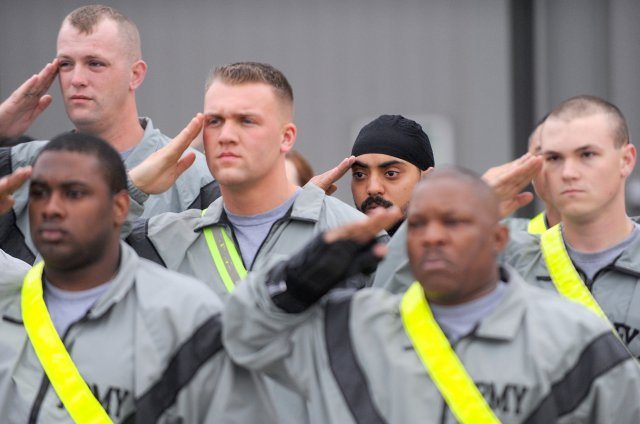When Spc. Simranpreet Singh Lamba was a kid, he dreamed of joining the military.
In the end, though, things weren’t that simple. Lamba, 27, is a Sikh, a member of a 300-year-old religion founded in India. Sikhism asks that its followers not cut or shave their hair, so men wear turbans and full beards — and as such are unable to join the U.S. Army without seeking case-by-case exemptions to uniform policy.
“The granting of these accommodations is very rare,” said Amardeep Singh, director of programs for the Sikh Coalition.
Currently serving with the 201st Battlefield Surveillance Brigade at Joint Base Lewis-McChord, Lamba is the first enlisted Sikh Soldier in more than three decades.
In fact, the only religious accommodations granted to Sikhs since the policy was enacted in the 1980s were granted last year, first to two officers and then to Lamba. For a group with a long history of military service, this is an important step.
“That’s what a life of a Sikh is. Our ancestors were warriors,” Lamba said.
With 20 million Sikhs worldwide, Sikhism is the planet’s fifth largest religion. It is also one of its newest, and deeply values the principles of justice, equality and truth. The monotheistic religion also emphasizes service to others, particularly in the armed forces.
In the United States, however, requests for accommodations for religious practices are granted only on an individual basis, and are frequently denied for reasons of unit or individual readiness, unit cohesion and issues with morale or safety.
“Obviously this has been a point of pain for our community,” Singh said.
Lamba, originally from India, spent his childhood dressing up in uniforms and practicing the perfect salute. He wanted to join the Indian Air Force, but his parents told him to put his studies first.
He came to the U.S. in 2006 to earn a master’s degree in engineering from New York University.
At the time, he thought serving in the U.S. military would be impossible. But when Capt. Kamaljeet Singh Kalsi and Capt. Tejdeep Singh Rattan were granted religious accommodations for their articles of faith, Lamba thought he would give it a try.
“When I came to the U.S. I decided to make this my home, make this my country,” Lamba said.
For him, there was no reason not to fight for it.
Because he was not a U.S. citizen at the time, he enlisted and was originally told an exemption would be made. When his request was formally denied he appealed it with the help of the Sikh Coalition in New York.
Nine months later, in August 2010, he officially joined the Army and became a citizen the day he finished basic training.
Now a combat medic, his challenge is to prove that he is exactly the same as any other Soldier ” both for himself and for Sikh Americans in the future.
“I wear the same uniform. I do the same thing. I get paid the same. I come to work at the same time. I do PT with you guys,” Lamba said.
The only real difference is his turban, five meters of cloth that he wraps around his long hair each day. In garrison, he wears a black turban with a flash on the front, similar to Soldiers’ berets. When he’s in the field, he uses a camouflage under-turban that fits under his helmet.
He even takes part in protective mask exercises just like any other Soldier, using petroleum jelly to create a seal in spite of his beard.
All told, he’s spent a lot of money on custom items so he can satisfy both his religious needs and the Army’s uniform requirements. It’s not something that he minds.
“I’m doing my job. I work, I’m happy that I’m serving,” Lamba said.
For the most part, Lamba says he’s had no issues integrating with his fellow Soldiers. Most are curious — in fact, he’s come to expect an audience when he ties his turban after physical training.
“I actually asked him a lot of questions,” Sgt. Frine Santiago, 201st BFSB, said.
She found that he was easy going and open, which eased the transition. Still, some have trouble seeing beyond his turban. Occasionally people are shocked. Others take longer to warm up to the idea.
Pvt. Ryan Jones, 2nd Brigade, 2nd Inf. Division, met Lamba in Advanced Individual Training and sometimes takes it personally when people find it difficult to see beyond his turban.
“If you hang out with him, you don’t even realize he’s wearing a turban,” Jones said. “He’s a normal person. It bothers me that people think otherwise.”
Lamba just laughs it off, though, and continues to do his job.
“If people get vocal about it, he just kind of ignores it. He just does his thing,” Jones said.
When it comes down to it, Lamba is aware that he is a pioneer. He isn’t just a Soldier — he’s representing what Sikhs can do in the U.S. military.
“He’s our Jackie Robinson,” Singh said.
In fact, the Sikh Coalition would one day like to see a formal change to the uniform policy, enabling any Sikh Americans to walk into a recruiting office and volunteer for their country as easily as any of their peers.
Singh is confident that Lamba, Kalsi and Rattan will demonstrate that Sikhs are capable of being excellent Soldiers, turbans or not.
“At the end of the day, when Soldiers are out there in the field, on the ground, you’re looking for a Soldier who can do their job,” he said.










